We can only store so much food for a SHTF situation, and what we do manage to store won’t last forever. Eventually we’ll need to begin producing food, and it’s important to make sure we’re prepared for that day. While storing some supplies for staring a garden or tending crops certainly wouldn’t be remiss, your knowledge of how to grow what and when will be even more valuable.
There’s a distinct chance that water will be a little tougher to come by in a survival situation, and that moving it from one place to another will be far more complicated than it is for us today. When you prepare for the eventuality that you must grow your own food, your success can hinge on whether you remember to take this into account or not.
We’ll take a look at some crops that do well without irrigation or a ton of watering so you can plan ahead.
Black-Eyed Peas
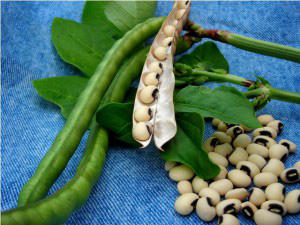 Popular in the south, this variety of plant will grow in even the hottest, driest summers. Harvest may take some time if you have to do it by hand, but they’re easy to prepare for eating. The legume produced is high in protein, and they’re great for a survival garden because they’re good to eat at every stage of development.
Popular in the south, this variety of plant will grow in even the hottest, driest summers. Harvest may take some time if you have to do it by hand, but they’re easy to prepare for eating. The legume produced is high in protein, and they’re great for a survival garden because they’re good to eat at every stage of development.
Plant these once the soil gets over 65 degrees F. Place them in a nice sunny spot, and plant in rows at least 2 ½ feet apart with the seeds 2-4 inches apart. They’ll need to be planted at a depth of about 1 ½ inches.
Related: How to Adjust the pH in Soil and Water for Abundant Harvests
Corn
You may be thinking of commercial corn, which oftentimes does require irrigation in many climates, but there are far more drought-tolerant varieties out there than the ones currently used by commercial farmers. You may still need to water in drier climates or years, but it’s not impossible.
Chard
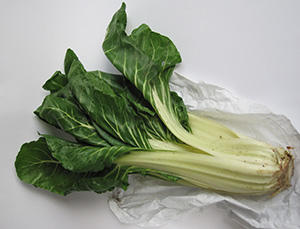 Chard is a fantastic survival crop because you can grow it more than once a year, it produces quickly, and you can eat both the stalks and the greens. It’s rich in nutrients, making it a powerhouse crop for survival.
Chard is a fantastic survival crop because you can grow it more than once a year, it produces quickly, and you can eat both the stalks and the greens. It’s rich in nutrients, making it a powerhouse crop for survival.
For a spring harvest, plant 2-3 weeks before the last expected spring frost. For fall harvest, plant about 40 days before you expect the first frost of the year. Plant seeds an inch deep, 18 inches apart, in rows 18 inches apart. You can harvest this plant several times, but make sure you pull up the whole plant, root and all, at first harvest to make sure your plants don’t overcrowd each other.
Melons
Certain varieties of melon do okay with little water and little effort expended. Cantaloupe, honeydew, and watermelon are all options, and they’d make a spectacular treat in a SHTF situation.
Berries
Berries that grow on bushes, like blackberries and raspberries, often produce without any watering whatsoever. Even some varieties of strawberries may do okay without watering.
Related: If You See This Berry, You May Want To Harvest It
Jerusalem Artichoke
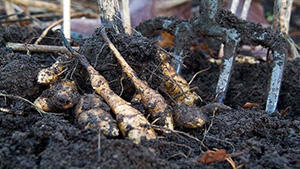 These tubers, also known as sunchokes, are a very versatile food. Sliced up fresh, they’re a lot like water chestnuts. You can cook them like potatoes or pickle them, as well. The part you eat actually grows underground. The best part? They’re a perennial, so they’ll come back year after year.
These tubers, also known as sunchokes, are a very versatile food. Sliced up fresh, they’re a lot like water chestnuts. You can cook them like potatoes or pickle them, as well. The part you eat actually grows underground. The best part? They’re a perennial, so they’ll come back year after year.
Plant these tubers in early spring, and the method is similar to that you use for planting potatoes. You plant whole tubers or pieces of them 3-5 inches deep. Rows should be 3-4 feet apart, plants placed about 2 foot apart.
Peppers
Some varieties, like jalapenos and certain types of chilis, will tolerate drought better than others. Either way, peppers have the potential to be both food and medicine in a SHTF situation, and they pack a flavorful punch that you may be sorely lacking if times get tough.
How you plant these will depend upon which varieties you’re planting, so make sure you follow the directions for the specific type you’ve got.
Related: Homemade Hot Pepper Cream for Arthritis & Joint Pain
Amaranth
Amaranth is another dual-purpose crop. You can eat both the leafy greens and the grain-like seeds of the plant. While it’s technically an annual, the falling seeds will oftentimes grow volunteer plants the next year. How you plant this one will also depend on the variety planted.
Chickpeas
Hummus, anyone? Chickpeas, also known as garbanzo beans, grow well in dry areas. Another high protein legume, chickpeas can make a great dietary staple in a SHTF situation.
Okra
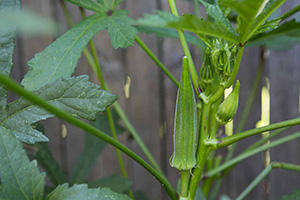
Even in the hottest, driest summer seasons, okra tends to produce well.
It’s also delicious pickled, which makes it good for food storage in a survival situation. It’s great because it continues to bear fruit for a while, and it starts producing sooner than most plants.
Be careful to protect your hands from the little spiny hairs found on the plants and the okra itself. They can cause major irritation.
Other Tips for Raising Food in a Water-Challenged Survival Situation
Here are some additional pointers for growing food where irrigation and intensive watering isn’t feasible:
- Stick to heirloom varieties when possible. They were developed to thrive before massive irrigation and garden hoses were a thing, so they’re more likely to produce for you under harsh conditions. You may find you can even grow tomatoes or other fruits and veggies that you’d have never imagined possible.
- Choose varieties of seeds specifically for their drought tolerance. Some varieties are much hardier than others.
- Use plenty of mulch to help the ground retain moisture. Mulch doesn’t have to be store-bought wood mulch; (seedless) grass or shredded leaves should do the trick.
- Use permaculture or companion planting techniques to give your plants the best chance at production.
- Choose your survival crops based on your climate. If you live in an already dry climate, you may be a little more limited. You can test out your survival gardening skills before the SHTF to determine what will work best for your situation.
Final Word on No-Water Crops
Almost without exclusion, there’s a cadre of crops that you can grow even without irrigation, intensive watering, or modern equipment. Be sure you plan ahead and plant a dry-run survival garden before you find yourself actually relying upon it as your main food source.
You may also like:
 How To Plant Your Orchard To Have Fruits All Year Round
How To Plant Your Orchard To Have Fruits All Year Round
An Insanely Effective Way to Build a 5 Year Food Stockpile (Video)
5 Medicinal Plants that My Grandmother Grew in Her Backyard

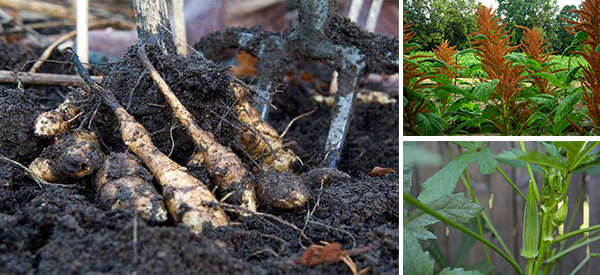













Sorry, I have to disagree with certain points in this post.
Chard, cantaloupe, honeydew, and watermelon require regular watering if the ground isn’t covered with a heavy mulch to conserve moisture. Without ground cover the plants suffer in the hot summer weather.
I had great luck growing chard with minimal attention. It out produced the rest of my garden and was a handy resource when I was cooking.
It got to 112 degrees last summer and the melons were fine. They’re a commercial crop in the Phoenix area, and they get up to 120 degrees. they do irrigate, but not mulch. It depends on the variety. Chard? erk. I like beets, but not the tops.
And try growing them in south Florida even with plenty of water.
Melons not needing much water? They are 90 percent water. So in a drought situation they will need to be watered quite often. Once every day or two days. I have grown black eye peas okra, corn , several kinds of peppers, and three different kinds of melons in east Texas and all require watering once a day, maybe you can get by with waiting every other day in a drought situation. They wilt quickly when it is sunny and hot.
I don’t know what part of America you live in, but here in the high deserts of Arizona we’d all starve. In 2018 we went 6 months without a drop of rain. This year we’re having unusual amounts of rain, but we would have all died last year and wouldn’t know it.
35 miles north of Tucson, east of Oracle: 2018, two heavy showers in April, no rain for 3 months, then the monsoons hit. The early one was so bad with hail, it broke holes in the vinal siding on the north of the house. One man a few streets down lost the rear window of his care to a piece of ice. But, the gardens thrived on a minimal amount of irrigation (soak twice a day for three days, then let it go till it blooms). Most of the seed comes from Native Seed Search. Porter tomatoes are from Texas, and like the heat. Chimayo peppers hate the heat but kept blooming till hard freezes burned off the tops. There was plenty of mesquite beans, meaning they got enough rain the year before. Yucca, soap and banana, put up a few stalks, but this year, everything is booming. Garbanzo beans planted in January and February bloomed and gave a heavy yield. The cactus fruit is coming on. Last year it was heavy, but quail and other birds opened them and ate the seeds, wrecking the fruit. Major problem: Most rodents disappeared over winter. There were hundreds of rabbits and ground squirrels last fall, now I have one ground squirrel in the area, and one rabbit. Coyotes are taking dogs and almost wiped out the quail. niio
Jerrusalem artichokes can become uncontrollabe. They will take over if not contained.
like how bamboo can take over? as in they just keep growing and eventually spread to the rest of one´s land?
The tiniest tuber left in the ground will grow and it’s virtually impossible to harvest them all. My crop of i plant became 200 after 2 years and that was in a raised bed.
Perhaps the best method of growing perennials that can start multiplying out of hand is to use a growing box or planter. That way you always have those plants on hand. There may come a time when growing a food source that can easily grow wildly without your assistance may be an important blessing. Even bamboo (I live in Florida where it grows out of control) might be a wonderful bartering item for wood & carriers for transporting water.
Also known as sun chokes, the other problem comes with the actual consumption of these tubers: horrific, explosive, room-clearing flatulence. They don’t call ‘em fartichokes for nothing. If anyone knows a preparation technique that ameliorates the side effects, I’d like to know what it is.
From: https://hotcheapeasy.com/2014/11/07/artichokes-or-fartichokes-we-test-them/ and: https://en.wikipedia.org/wiki/Jerusalem_artichoke
Gerard’s Herbal, printed in 1621, quotes the English botanist John Goodyer on Jerusalem artichokes:[22]
…which way soever they be dressed and eaten, they stir and cause a filthy loathsome stinking wind within the body, thereby causing the belly to be pained and tormented, and are a meat more fit for swine than men.
Watermelons are from North Africa, and you need to get varieties of plants suitable for your area. If your soil is deep and loose, then why would you water melons? Same with the beans and ‘peas. I have Yoeme strngbeans blooming in the garden (central AZ), and will have Yori Cahui ‘peas planted ASAP. niio
Good points! Sadly most folks only see how we do things NOW, with all the modern stuff we take for granted… Many do not look at the history of the food nor other ways of getting stuff done… In my part of WY we get 11-14 inches of water a year. I talked with a local rancher about putting swales on part of his land to help retain what rain he did get. [prior I had discussed it with the water dept and they liked the idea] The rancher flat out stated that ‘we ‘ve never done it that way before and it can’t be done” hummm thinking like that is maybe part of why he nearly lost his ranch…. 2 thoughts… 1. stacking Rocks around the base of the plants to at as an ‘air well’ for dew to collect and drip to the roots. and 2 have you seen ‘greening the desert” Geoff Lawton ???
You’re kidding me. we get 13″+- a year, and it’s done here. If Native Americans did it for centuries, piling loose rocks in dry ravines, why not in Wyoming? Laws, ma, I think the Bent family was doing that up your way before the War Between the States, and they were wolfing their cattle then, like the Kiowa did. there are swales near here, that were put in by the WPA that are still in good condition, and no one worked on them in decades. Yeah, I like Lawton. Good teacher, good researcher. niio
You’re going to be eating a lot, though. That should keep it under control to an extent, or you could trade for something else. It won’t seem as much in a shtf situation and it’s a staple crop.
Can you also feed it to livestock?
Livestock love the tops and roots. Hogs will eat every one they can sniff out and get fat on them. I gave one small tuber to an old man, a very cocky old man who bragged he could grow anything. I warned him do not use fertilizer. He did anyway and a few years later was cussing me for giving him the tuber. I ask, what did you do? Plenty of nitrogen, of course, and niio 🙂
Good to know article. Thanks for sharing.
Appreciate the hands-on comments of followers of this site. There is nothing that beats “Been there. Done that. This is what works for me.”
Lots of times there is a big gap between theory and real life as we old timers have found out, sometimes to our chagrin and dismay.
Bob Boudine, the president of Motel Six is quoted as saying, “The difference between education and real life is that education teaches you a lesson and then give you a test. Real life on the other hand, give you a test that teaches you a lesson.”
Unfortunately for me, too much of my education has been real life education. Benn there, done that but wish I hadn’t.
Ha! I had the same thing happen with Horseradish. Boy those roots go deep!
Sunchokes here in plain dirt must be watered now and then or if wilted too much they die out. A little wetter climate and yes they take over. Okra did well if the weather were hot enough and just minimal watering. Black eyed peas take some watering but not as much as other peas or beans. My last stand of Swiss chard did very well with infrequent watering. We have several native dent corns here that are dry farmed by the native peoples. They do ok.
I saw a neighbor grow a field of watermelons with plenty of water till the plants were 1′ then he watered once midseason and once more as the melons were nearing harvest. Mine always seemed to need much more water than that. My box choy once mature was fine with very little water. Same for asparagus and rhubarb. They need moisture in the spring but can get by with surprisingly little after that.
Most herbs and vegetables once established $till need water every two or three days until were hit close to 100F then they need daily water. Plenty of compost in the soil and some rabbit droppings help loosen soil, enrich it, and help hold moisture longer than my hard Adobe Sandy clay would.
Someone gave me a case of unused adult diapers that had been sitting in an old van so long the plastic that the sun hit was disintegrating. I use some of that absorbent fiber in pots to help hold moisture longer. I tried some in the soil of a small raised bed where I planted one yellow pear tomato. I could cut back watering to every three days and that plant made a wild mound 5′ across and 4′ tall. A cage would have been better but in moving I just didn’t get around to building something. It bore fruit until a hard freeze. This year I plan to use leaves and twigs in my garden beds. One will be made over larger branches. I’m aiming for water catchment basins for every bed. We get summer monsoons that come through as fast moving heavy rain producing thunderstorms in June and July. Then some snow in cold winters that together give us a moisture total of 12″ a year. Catching and using it is worthwhile. I’m aiming to get gutters on every shed, shop building and my mobile home so I can save all the rainwater possible.
I really enjoyed all of this information.I’ve got to write all this in my SHITF book. Thank you
Working on farms and ranches there is usually an area where the laborers have been sitting in the shade to eat lunch over years, and I’ve seen plants growing from discarded food as the article says, cherry tomatoes, cantaloupe, watermelon, onions, marijuana, all in the hot Texas summer with nothing more than the rain. Don’t know why stuff gets so thirsty in my garden.
You also have to consider the soil in your garden. If it is a sandy loam and it is three or four feet deep then the water will filter through it pretty quick. If you have a hard pan under your top soil then the water will stay at the surface and could cause a flooding effect especially if your garden area is flat and not much slope for water to run off. So it may not necessarily be the plants that are using up the water. I have a hard clayish soil under my garden and through the years have added sandier material and compost and it works really well. Retains the water and with some slope from west to east the excess water runs off. In good rainy years like we are experiencing in east Texas this year, I have only irrigated twice when the plants were very young. So types of soil and lay of the land is a big factor when considering water needs. Sorry for so long just thought I would share.
How’s you Ph? Caliche is the major problem in my area. Roots will not go thru it, no matter how thirsty plants get. Most of what I dug is soft till it dries (AKA desert concrete). Most farmers take care of the problem by adding some sulfur to the soil. It converts caliche to a type of lime. BTW, Portland Cement has 3 caliche mines in Texas.
I’m digging down 3 feet and packing it with wood and logs, anything that will decay and hold moisture. the beds from last year are doing well. niio
I think the comments on this thread really drive home the thought that was posted on another thread by a real life farmer, “You don’t want to become an OTJ farmer after the SHTF. Your best bet for survival is to befriend a compatible real life farmer.”
We see from real life vegetable growers, whether they identify as farmers or not, that there are a great many variables in getting plants to grow.
To follow up Ivy Mike’s comment, it is amazing how many plants are growing in my yard that I didn’t plant. The seeds come from bird droppings, wind blown, who knows how else. My yard gets little care and in recent years, less water as my wife is wont to point out. Sometimes it seems seeds carelessly discarded and unattended grow better than seeds carefully nurtured. But just try ignoring the plants you want to grow and see how that turns out.
Have to agree wannabe. My soil is perfect for Adobe building blocks. My raised beds are close to an equal mix of soil and compost or rabbit droppings. Beds for root vegetables often have a large bag of potting soil added to the mix. It keeps it softer and helps add volumn.
At planting time I top dress most beds with a thin lather of rabbit droppings then lightly mix it into the top 3 inches. It feeds the green growth. For greens vegetables that’s it. For blooming and fruiting once the plants are growing well I water with a tea made from cleaning the chicken pen last fall. I simply the cleaned material in a 55 gallon drum. 1/4 barrel of solids then fill to the top with water. Stir now and then. I fill my watering can 1/3 tea and the rest water. It works wonders. Sometimes I add Epsom salts to the barrel mixture. I plant individual plantings with crushed egg shells, bone meal, or fish emulsion and somethings get an aspirin. Tomatoes, three sisters hills, and mellons get all three things or I water later on with a mix of dissolved calcium tablets or crushed egg shells that have set a week in water that is stirred daily, aspirin and the fish emulsion in lots of water. It encourages strength and blooming. The rest of the time I water with old soaker hoses I was given. I have some drip system stuff and will try doing drip in some new beds. For now I just drag and connect a hoses to 4 rows at a time. I hope to change that soon to be easier on my injured knee.I have a lot of old heavy duty hoses that were given to me. I’ll cut them to length with new ends added to connect multiple rows so I can just connect to areas instead of watering one row at a time. It just takes time and a bit of money. I’ll do it area by area as I can.
I have a new area where I’m going to try the method that builds up a tall raised bed over burried leaves and branches and sometimes even cardboard. I have a high pile of elm that has over winters laying on the ground. Each bed is built with a water catchment basin. For monsoon season those might work out to not need much additional watering at all. That would be wonderful and ultimately the rotting plant material will help feed what’s planted there. The idea looks good on paper. The water catchment area left to my natural soil will naturally become a thick layer of clay that will hold water after a while as the sand sinks away. Monsoons start in late June to early July. They last through August and sometimes into September. I’ll have to water until the monsoons come.
First frosts often come by mid September and first snow in the air by the end of october. Last frost date is normally about April 15. Yesterday was May 10th and some areas had a dusting of new snow. I just had rain but we had a 32 degree night May 8th. My heirloom dwarf corn will mature in about 2 months so its still ok to plant very soon. The native dent corn for roasting or making corn meal is the same, a short season corn often “dry farmed”.
I water it and fertilize it for a better yield.
Most things like tomatoes and pepper must be well started by the time they are set out or your just getting a harvest by the time it’s ready to snow. I like my mine nearly big enough to bloom by the time I set them out. That way I have time to enjoy them for awhile. By covering them I often get them to survive into mid winter or over winter to bear a second year. That takes old thick quilts or moving blankets and leaving them covered when it snows. This is high mountain desert So heavy snows are infrequent. There are many days above freezing when I can uncover the plants for days or weeks at a time. December and January I have to cover for nearly every night. Still I harvest some tomatoes through the winter and they will quickly begin blooming again if the survive to spring. If I can get my pit greenhouse built this year I can usually count on harvesting tomatoes year around by using grow lights. I did that at my other home before returning here. It wasn’t large. Just 5′ wide x 12′ long and 6′ deep. But I grew thing there all winter without added heat. The last flowers and transplanted mature tomatoes set in there survived a record breaking -46 degree night. It killed everyones young fruit trees to the ground.
I saved the rafters form an old 12′ wide mobile home I tore down to bring in my newer home. Those will go over the new pit to carry a simple sheet plastic roof. The 2x6s I saved that were the floor joists will carry a dirt roof over a cellar room at one end of the pit. My chicken pen will be above that roof so the room isn’t obvious and the litter is nearby for composting in a corner of the pit. Compost will add some heat and I’m considering moving the rabbits into the pit for an air exchange and added body heat. Plants need what we mammals breath out and we need the oxygen they put off. The cellar will exchange air with the pit with not so obvious entrances from the pit and up through the chicken pen. Runnoff from the roof will be trenched on the sides to feed a sealed masonry cistern as a water source for the pit. A small solar pond pump can then be used to water in the greenhouse. My old one was smaller than I’ve planned for the new one but having the rafters expands the possibilities. I need new 2x4s through the rafters for stability and cinder block flat caps to set the ends on along the walls. I have most of that gathered and much is being recycled from the old trailer. Craigslist is a good free or cheap source also.
I’m still working on a gray water catchment. It’s going to run into a compost pit, then used, to knock out the grease and the smell. I plant a lot of sorghum sugar cane, just scatter it thru the garden. Agronomists claim it can crack plowpan, something cousins in the East had trouble with. they like oilseed radishes (daikon) planted in fall, after the truck patch (one has about 200 acres of ‘patch) is done. I use black Schifferstadt. Both will grow in brick works adobe (radishes to 8 feet and sorghum down to 12 feet). Right now some are going to seed, and that’ll be planted, scattered thru the garden beds, in early October. Right now, the sorghum is a few inches tall and shivering in the cold. The chilis are in full gear, so I can stop buying fresh peppers soon. We used to have high rabbit hutches, so the chickens could ‘compost’ the rabbit manure. Fewer bugs in the hutches, and they were a lot easier for Dad to help. Shrapnel in his back made stoop labor hard. Still, he did the shoeing till an older brother was big enough to handle the horses. I still don’t know why he didn’t let Mom shoe. she was a shorty and liked doing that. And, the horses never caused her a problem. Use boys, wow, those nags get nervous. niio!
The weather has been cold and damp, for Central AZ. I’m holding off planting southern peas. We get a few days when the heat blasts us, but the tomatoes and fruit trees stopped growing. This, though, is perfect for Scarlet Runner beans, which like it cool and damp. In mild climates, they’re a perennial but prone to spider mites. Get a modern variety. The older types have a lot of strings. The beans are also called Oregon lima beans, but are much better than lima beans.
Our maize is usually planted with the monsoons, but it tolerates drought better than most. The Tarahumara had varieties of it that bore ears even when droughted, some with up to 6 ears. Back in the 90s, Monsanto came to them with the blessings of the PRI and distributed their drought-tolerant GMO. They didn’t bother to tell the Tarahumara it had a trigger. 9,000 people starved to death, thanks to Monsanto and the PRI, and the news media stayed silent on it.
Chard, to me, is nasty tasting. As I raise beets, anyway, I can eat the tops.
Sun chokes! I’m looking for a high-fructose French variety. The thing is, they have to be stored in a damp place (like the garden) for weeks for the starch to turn to sugar, then make a sweet meal. This is a great one for a hidden garden. Most people only see the ‘sunflowers’ that bloom most of the summer and never realize the food is underground.
Started some chiltepin seeds (AKA bird peppers/little devil peppers), but this weather has me worried. Best place to plant chilis is under a mesquite or another legume. The weather has the Chimayo chilis producing a lot of fruit, though. They prefer cool days and nights, and can handle some frost. Most peppers wither when the temps get down into the lower 40s. Chimayo kept blooming till hard freezes killed them. Even then, if protected, they’ll sprout.
Amaranth seedlings are sprouting. Bugs do not care for the red varieties (red leafed). If you can’t grow this, better start praying, or go for lambsquarters, a near relative. Seeds of both were important crops to Native Americans. Lambsquarters can accumulate nitrates in droughty conditions. Leaves can be used, but with some caution. It’ll grow any place but Zone 3, and there may be a type for there. It’s frost hardy, unlike amaranth.
Garbanzo beans did great in the winter garden. They sailed through snow and freezes with a minimal loss of plants. They like to sprout in the cold, but mature in the heat. Immature seeds taste like peas. niio
Chilitepin is great but but always reminds me of an explosive bomb. My uncle always kept them in a small bowl on the table. They grew in all the flower beds around the house. He also had tiny wild tomatoes in the flower beds. He’d gathered both out in wild areas along south Texas desert near the Mexican boarder.
I like garbanzo but never tried growig them. Ill have to try some
May 16th and it was 32 degrees at dawn. Crazy weather. Usual last frost is April 15th. Injuries stopped all work for most of the past year. My walapini or pit greenhouse at the old place was wonderful. If I had the one planned for here finished we’d be eating fresh produce by now. A few things in the ground but growing slowly and have to be protected still at night.
June 4th. Last freeze was 4 nights ago. Today we had 40 mph winds and 1/2″ hail deep in the yard. Looks like snow. Good it moved fast or we’d have lost windows.
My new water bath scanner rack arrived yesterday. Pot is fine but after 57 years the rack is in poor shape.
I planted fruit on this land 37 years ago. Some needs replaced and I’m adding more that I always wanted. The box of plants arrived today. 3 apples, 2 cherry, 2 pears, 2 plums, an elderberry, a hop bine, + raspberies,, strawberries, and a mulberry tree. I have grapes here to be planted. Hopefully its a better years for trees and vines that it is for a vegetable garden.
Y’all having too much fun (means, it’s not boring). You have a great garden. With all that wind, are the blooms getting pollinated? Wish I were there to help. But, one pear and a goji supposed to be here tomorrow. We’re stuck on what we can and can’t plant. This is Zone 9A and most trees I’d like need more cold. No European cherries and I can’t find Capulin, a native domesticated. Some folks up in Oracle are planting sand cherries, another native, and drought resistant. They produce from Zone 8-Zone 3. Only thing, they need to be dead ripe, but taste great. No strawberries, yet, but this fall they can go in. It gets too hot for them down here, but, AZ U has some that are heat-resistant and don’t need a lot of cold. I have two waterbath canners, and one is older than I am. And, that’s the best one, from a Mennonite family’s yardsale.
Garbanzos like cold weather. We can plant them here, for best results, in late January. Like peas, they like cold nights. I still haven’t taken the floor out of the tool shed for a greenhouse. Hope there’s not too many surprises, like that rattler, hiding under there. He and Bubba have the same bad attitude, does not play well with others. Or many the rattler loves Bubba too much. Just a kiss and a hug 🙂 and with that to entertain your evening, niio
What does “niio” in some posts mean?
It’s a contraction of the Iroquois-Susquehannock term Ni TsigeYui Orenda, Walk in God’s beauty. For more (probably useless 🙂 trivia a peanut is an earth bean.
Tsi Yu! (Beloved (Holy) Spirit, a reminder to be respectable), also pronounced See you 🙂
ALSO DUMP OLDFOOD IN RIVERSS SO TO HELP THE FISH GROW THEN THERE WILL BE SO MANY FISH ONLY FOOD NO WRAPPERS !!
That only works for carp and ‘cats. Get busted, you can be arrested for pollution, dumping garbage, and attempting to trap fish. ‘Sides, scraps rot and make the plants grow. niio
I have a small apartment in the city and a really tiny patio… but I am working on learning how to grow potatoes. I have yukon gold and some purple potatoes that were accidental starts in the bottom of my potato/onion drawer.
I am learning what I can about starting new plants from things that can be partially eaten.. and I try to keep plants on hand that are dark colored.. good for calories and nutrients.
I have some locally sourced seeds as well.. hawthorn, wild blackberry, wood rose and maple. Those may find a home somewhere in the soil close by so I know where to find them later. Many of the local seeds take years to mature into viable plants.
I am learning more about wild food sources and I know there are things I can grow and harvest quickly. I really appreciate all of the knowledge in the comments section.